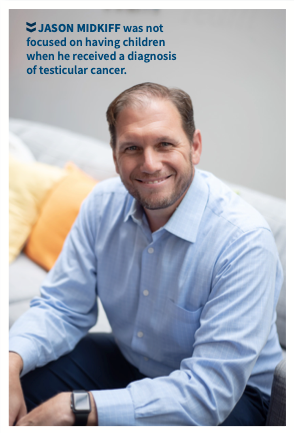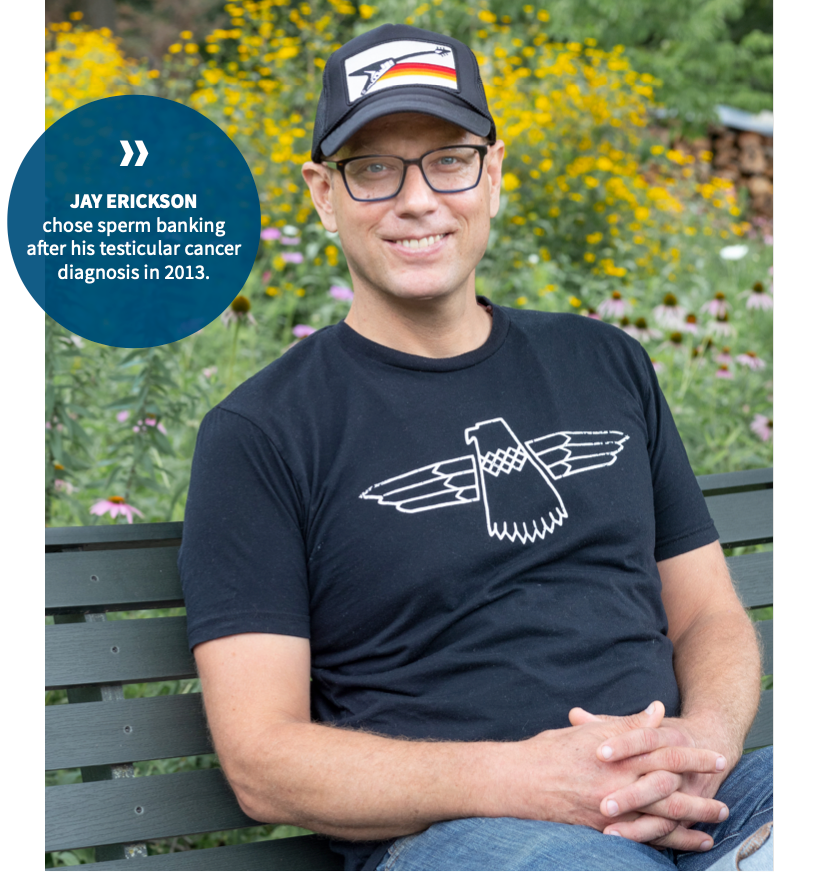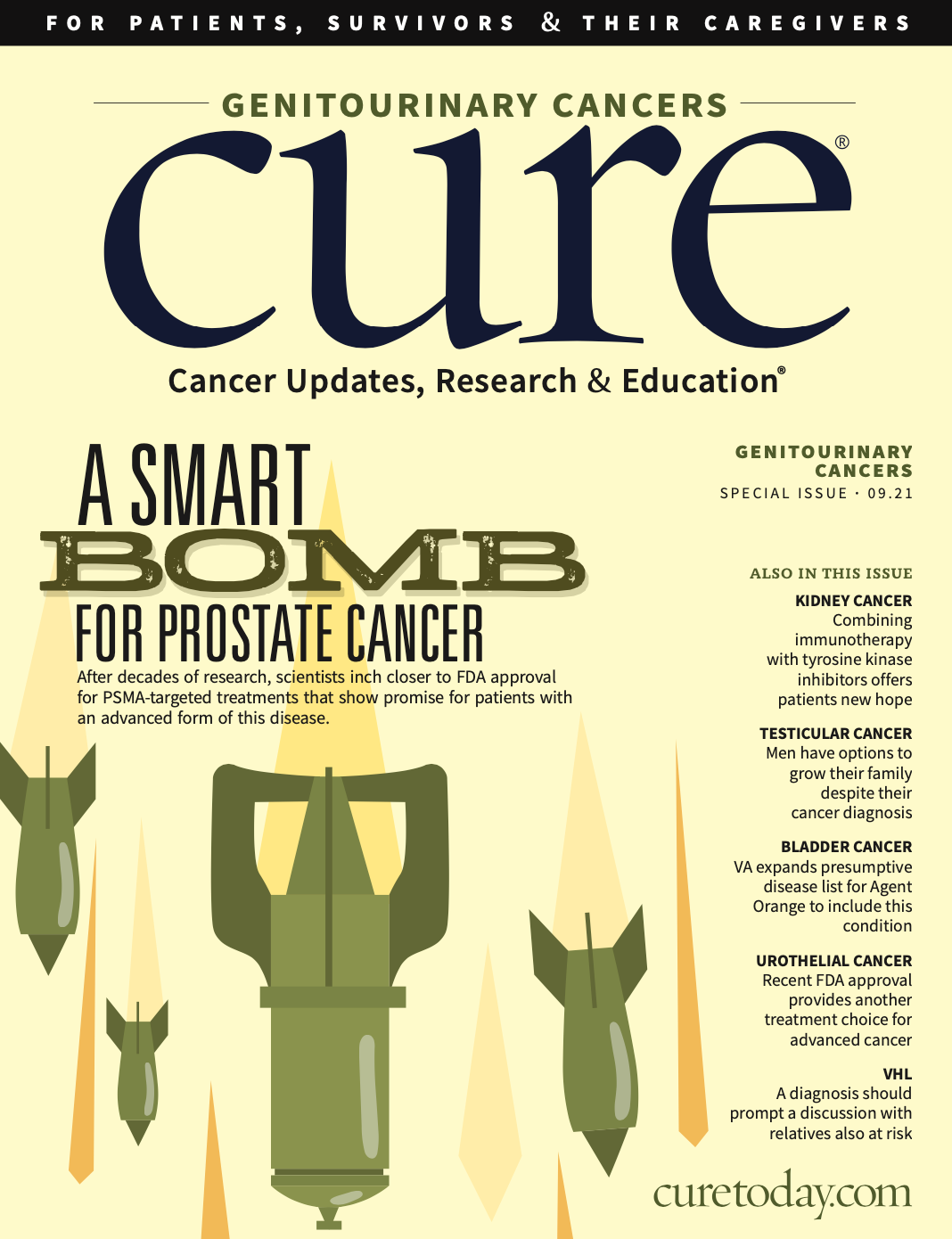Publication
Article
CURE
What Patients With Testicular Cancer Should Know About Fertility
Author(s):
Despite a testicular cancer diagnosis, men have options when it comes to starting or growing their family.
When Jason Midkiff, 46, was diagnosed with testicular cancer 20 years ago, he was not concerned about whether he could have children in the future.
“I was pretty focused on my career and didn’t have a significant other at the time,” Midkiff recalls. “I think of myself as having been young, dumb and foolish.”
To be fair, Midkiff was facing an aggressive form of testicular cancer called pure embryonal carcinoma. Testicular cancer is subdivided into seminoma and non-seminomas, with embryonal carcinoma falling in the non-seminoma category. Embryonal carcinoma, which occurs in about 3% to 4% of testicular cancers, according to the American Cancer Society, tends to grow rapidly and spread outside the testicle.
Jason Midkiff was not focused on having children when he received a diagnosis of testicular cancer.

Midkiff first noticed some swelling in one of his testicles at age 26. Swelling is a common symptom of testicular cancer but can be due to multiple causes. Midkiff’s primary care physician initially treated him for inflammation before ultimately recommending he undergo an ultrasound.
The ultrasound revealed a mass, and Midkiff was referred to a urologist for a biopsy.
“I had a surgery to remove the mass and was scheduled to undergo a second surgery to remove some of the lymph nodes in my groin,” Midkiff says.
His urologist initiated a conversation about possible infertility prior to his second surgery. Unfortunately, Midkiff says, he figured it would not be a big deal for him.
Today, a father to five adopted children, Midkiff says he is not sure he would do anything differently.
“Hindsight can be tough,” he says. “But I can’t imagine my life without the kids I adopted.”
Effects of Cancer
A testicular tumor is a space-occupying lesion in the testicle that will destroy some of the sperm-producing tissue in that space and consequently decrease sperm production, explains Dr. Larry I. Lipshultz, a professor of urology and chief of the Scott Department of Urology’s Division of Male Reproductive Medicine and Surgery at Baylor College of Medicine in Houston.
In fact, studies have shown that 30% to 50% of men diagnosed with testicular cancer have low sperm counts or dysfunction of available sperm at diagnosis.
“Testicular cancers can also produce certain hormones, such as human chorionic gonadotropin (HCG), alpha-fetoprotein or lactate dehydrogenase, that can upset the endocrine system and disrupt normal sperm production,” Lipshultz says.
The standard of care for treating testicular cancer is radical orchiectomy — removal of the entire affected testicle.
“Almost right away, men with testicular cancer are down one sperm-producing unit,” says Dr. Sarah Vij, a male infertility and andrology specialist at Cleveland Clinic. “Additionally, many men who have testicular cancer will require additional therapy like chemotherapy or radiation to the remaining testicle.”
Men treated with orchiectomy alone have the lowest risk of long-term fertility concerns, Vij says.
Some men, like Midkiff, may require retroperitoneal lymph node dissection to remove the retroperitoneal lymph nodes, where testicular cancer often spreads first. In some cases, this surgery can affect the nerve bundles that control the way semen exits the body, causing retrograde ejaculation, explains Dr. Matthew T. Campbell, an assistant professor of genitourinary medical oncology at The University of Texas MD Anderson Cancer Center in Houston. During retrograde ejaculation, semen flows back into the man’s bladder instead of out through the penis, resulting in infertility.
In addition, chemotherapy and radiation can be toxic to spermatogenesis — the sperm-producing process. The chemotherapy drugs used to treat testicular cancer including cisplatin and ifosfamide tend to be the most toxic to the testicles, Campbell says.
“Chemotherapy agents are a standard of care for men with metastatic testicular cancer or used to prevent the recurrence of testicular cancer, and while they can contribute to infertility, not all men who receive (this treatment) will have lifelong infertility,” Campbell says.
“Another important piece of the puzzle is that treatment with orchiectomy, and later with chemotherapy, can cause low testosterone levels,” Campbell adds. “Low testosterone can impact fertility by affecting a man’s sex drive, causing erectile dysfunction, and reduce production of sperm.”
In addition to the cancer and its treatments, other traditional risk factors such as age, smoking, alcohol use and obesity are associated with infertility in men.
Fertility Preservation
At the time of diagnosis, the main priority should be the cancer diagnosis and survival, Vij emphasizes.
“The discussion about infertility is hard to have, but it (needs) to be (talked about) upfront,” she says. “We recommend that all men with testicular cancer do sperm banking. Ideally, this is done prior to removal of the testicle.”
Sperm banking is the process of collecting semen and examining it under a microscope to count sperm cells to determine how healthy they are. The sperm cells are then frozen and stored. This process is sometimes called sperm cryopreservation.
Jay Erickson chose sperm banking after his testicular cancer diagnosis in 2013.

A small population of men may not be able to provide ejaculate or do not have sperm present in the ejaculate. In these men, surgeons can try to remove sperm from the testicle during the orchiotomy (a surgical procedure to remove one or both testicles), Vij says. This process is called testicular sperm extraction.
Jay Erickson, 46, chose to bank sperm after receiving a testicular cancer diagnosis in 2013. He says the disease was pretty advanced at diagnosis, with the initial ultrasound showing a large mass in his abdomen with tumors throughout his lymph node system and lungs. The physicians initially thought Erickson had sarcoma, but bloodwork eventually showed elevated levels of the hormone HCG.
Erickson’s physicians told him he had pure testicular choriocarcinoma, another rare form of testicular cancer occurring in about 0.19% of all testicular tumors.
Through fertility preservation before cancer treatment, Jay Erickson's daughter Juniper was born a few months after his last surgery, which he says was a big part of his healing.

Choriocarcinomas tend to be aggressive, and Erickson was told that this type of cancer was not always responsive to chemotherapy.
Prior to his diagnosis, he and his wife had been trying to get pregnant.
“During that initial conversation, we discussed prognosis, medical details and a treatment plan, but when infertility came up, it was really not on my radar,” Erickson says. Recalling the details of that day still elicits emotions for him. “I was going to start chemotherapy in two or three days, and the people at (Memorial) Sloan Kettering (Cancer Center) had a fertility specialist right there at the appointment with a messenger standing by — ready to bring a (sperm) specimen to a Manhattan cryopreservation bank that day.”
The details are hazy, Erickson says, but the specialists told him that there would be a good chance to have children using banked sperm and in vitro fertilization (IVF). To improve the couple’s chances of success, the specialists said, he should bank as many specimens as he could in the days leading up to start of his treatment.
Over the next year or so, Erickson endured the orchiotomy, several rounds of chemotherapy, a retroperitoneal lymph node dissection and several surgeries to remove masses from his lungs and a small bowel obstruction. During his treatment, he and his wife made the decision to initiate IVF.
“I had been able to bank three specimens. We were told one was not good quality, and we had one failed round of IVF,” Erickson says. “It was the last vial, our last hope.”
Their daughter Juniper, 6, was born only a few months after Erickson completed his last surgery. His daughter’s birth, he says, was a big part of his healing.
Jay Erickson, and his wife, Katie Rose, have another child, Iris, who was conceived naturally at a time when the couple thought they should consult adoption lawyers.

Trying to Conceive
Men treated for testicular cancer may still be able to have children naturally after their diagnosis. Vij says men who are treated with only surgery may not need to wait at all to attempt to have children. Treatment with chemotherapy and radiation, however, warrants waiting.
In general, Lipshultz recommends that men wait at least two years to try to have children naturally.
“Sperm production takes three to four months, so if you want to have sperm that have not experienced the impact of the chemotherapy or the testicular cancer itself, men need to wait at least a year or four cycles of sperm production,” Lipshultz says.
If men want to try to have a childly naturally, Campbell recommends trying for at least a year before consulting a fertility specialist.
“There is always a major component of psychosocial change that occurs post-treatment for testicular cancer that can contribute to stress, body image concerns or other things that could potentially impact fertility as well,” Campbell says.
Midkiff says that after he completed his treatment, he and his first wife tried to get pregnant for a period of time.
“I knew, though, that something was different (afterward) based on the volume of semen,” Midkiff says.
Tests confirmed azoospermia, which means there is no sperm in a man’s semen. Midkiff admits that he briefly thought about not being able to pass along biological traits to his child and about his wife not having the opportunity to be pregnant and carry a baby.
“I worked in education, though, and kids are a pretty big part of my life,” Midkiff says. “The idea of fostering or adopting kids was something I had already wanted to do anyway, so we ended up going that route.”
Today, he has two kids, ages 18 and 16, with his first wife and three more children, ages 11, 10 and 6, with his second wife.
After using their last specimen to conceive their daughter Juniper, Erickson and his wife also considered adoption. Erickson had undergone sperm analysis after his treatment and received a diagnosis of teratospermia, a condition characterized by abnormally shaped sperm.
“We were researching and meeting with adoption attorneys when my wife got pregnant,” Erickson says. That pregnancy was their daughter Iris, now 4 years old.
Prioritizing Fertility
Campbell says that every man diagnosed with testicular cancer should be counseled on sperm banking at the initial diagnosis and that these conversations should be part of standard of care.
“I see patients who are coming in with a diagnosis of testicular cancer, and I refer them for sperm banking,” Campbell says. “I go through the reasons why sperm banking should be considered, even if patients are not interested in conceiving in the near future.”
Campbell says that conversations about fertility should also occur with men who say they’re done having children.
“We discuss the fact that with testicular cancer treatment, there is no guarantee that they will be infertile,” Campbell says. “They have to still be careful of having children unintentionally.”
For those men who choose to bank sperm, Lipshultz says there are issues related to cost and access. A lot of the cryopreservation banks are in major urban areas, but some banks do offer mail-in sample kits.
The average cost of initial sperm banking and analysis is about $1,000, with a yearly fee of approximately $300 for storage, according to the Alliance for Fertility Preservation. These fees can vary based on location. The cost of testicular sperm extraction can be much higher, between $6,000 and $16,000. One must also consider the cost of using the sperm for artificial insemination, which costs about $1,000 per cycle, or IVF, which can be $15,000 or more.
In Retrospect
Midkiff was diagnosed with testicular cancer in October 2001 and finished his treatment in March 2002. He has had no cancer scares since then. Although he did not undergo any type of fertility preservation, he says he has no regrets.
“The No. 1 thing I would tell someone is don’t wait,” Midkiff says. “My cancer was so aggressive that if I had waited, I wouldn’t have made it.”
Erickson is more than six years out from his last treatment and still undergoes annual follow-up screening. He is very grateful he was able to bank sperm and encourages others to do the same.
“Bank as much as possible so that you have options,” Erickson says. “You don’t have to make a decision that day. Bank it and then forget about it, and focus on yourself, healing and getting better. That is No. 1.”
Erickson likened sperm banking or other methods of fertility preservation to the proverb “Trust in God, but tie your camel.” Have faith but take action.
For more news on cancer updates, research and education, don’t forget to subscribe to CURE®’s newsletters here.



